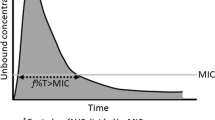Abstract
Two hundred and fifty-five neonates, infants and children, from 45 hospitals, who were receiving chloramphenicol therapy for serious infections were the subject of this study. Samples of serum and cerebrospinal fluid (CSF) were assayed for chloramphenicol and the patient's treatment regimens analysed. Less than 50% of neonates and 25% of infants received the “recommended” dose of chloramphenicol. In older children the recommended dose was used. Only 34% babies under 1 year of age and 50% older children had serum concentrations within the therapeutic range (15–25 mg/l). Thirty-one percent of neonates and infants had potentially toxic serum concentrations. Forty-three percent of neonates receiving chloramphenicol every 6h had subtherapeutic peak serum levels compared to 20% of those receiving the antibiotic every 12h. Concomitant administration of phenobarbitone or phenytoin had no effect on mean serum chloramphenicol levels. Serum concentrations of chloramphenicol were significantly higher in patients also receiving penicillin. CSF levels in 77 samples (39 patients) ranged from 1–60 mg/l. CSF from 44% patients contained less than 4 mg/l. Twelve neonates and infants (5.5%) suffered toxic side effects, four died. A further eight babies received an accidental 2- to 10-fold overdose and in three others an overdose was assumed following assay. No overdoses or toxic effects were reported in children over 1 year of age. Eight patients with impaired renal function had elevated serum levels and three showed toxic effects. In 22% patients dosage regimens were altered following assay. Even when the recommended dosage regimen for chloramphenicol is followed serum from all babies under 1 year of age should be assayed every 48–72 h if safe and effective levels are to be maintained.
Similar content being viewed by others
Abbreviations
- CSF:
-
cerebrospinal fluid
- SAS:
-
statistical analysing system
References
Ainley Wade, (1981) Martindale, The Extra Pharmacopoeia. Pharmaceutical Press, London
Berry DJ (1988) Reverse phase HPLC determination of chloramphenicol in small bio-samples. J Chromatogr (in press)
British Medical Association and the Pharmaceutical Society of Great Britain (1985) British National Formulary Number 9
Cherubin CE, Corrado ML, Nair SR, Gombert ME, Landesman S, Humbert G (1982) Treatment of Gram negative bacillary meningitis: role of the new cephalosporin antibiotics. Rev Infect Dis [Suppl] 4:S443–464
Davies PA (1977) Neonatal bacterial meningitis. Br J Hosp Med 18:425–434
de Louvois J, Mulhall A, Hurley R (1980) Comparison of methods available for the assay of chloramphenicol in clinical specimens. J Clin Pathol 33:575–580
Elliott TSJ, Ispahani P, Cowlishaw WA (1986) Gram negative bacillary meningitis in neonates: a glimmer of therapeutic success. J Antimicrob Chemother 17:245–250
Glazer JP, Danish MA, Plotkin SA, Jaffe JS (1980) Disposition of chloramphenicol in low birthweight infants. Pediatrics 66:573–578
Kauffman RE, Thirumoorthi MC, Muckley JA, Aravind MK, Dajani AS (1981) Relative bioavailability of intravenous chloramphenicol succinate and oral chloramphenicol palmitate in infants and children. J Pediatr 99:963–967
Lecour H, Seara A, Miranda AM, Cordeiro J, Sarmento J (1984) Treatment of 160 cases of acute bacterial meningitis with cefotaxime. J Antimicrob Chemother 14 (Supplement B):195–202
Mulhall A, de Louvois J, Hurley R (1983) The efficacy of chloramphenicol in the treatment of neonatal and infantile meningitis: a study of 70 cases. Lancet I:284–287
Mulhall A, de Louvois J, Hurley R (1983) Chlorampenicol toxicity in neonates: its incidence and prevention. Br Med J 287:1424–1427
Mulhall A, de Louvois J, Hurley R (1983) The pharmacokinetics of chloramphenicol in the neonate and young infant. J Antimicrob Chemother 12:629–639
Nelson JD (1981) Pocketbook of pediatric antimicrobial therapy. Hill Printing & Stationery Co., Texas
Sack CM, Koup JR, Opheim NN, Smith AL (1982) Chloramphenicol succinate kinetics in young children. Pediatr Pharmacol 2:93–103
Scott JL, Finegold SM, Belkim GA, Lawrence JS (1965) A controlled double blind study of the haematogical toxicity of chloramphenicol. N Engl J Med 272:1137–1142
Sutherland JM (1959) Fatal cardiovascular collapse of infants receiving large amounts of chloramphenicol. Am J Dis Child 97:761–767
Windorfer A, Pringsheim W (1977) Studies on the concentrations of chloramphenicol in the serum and CSF of neonates, infants and small children. Eur J Paediatr 124:129–138
Woodward TE, Wisseman CL (1958) Chloromycetin (Chloramphenicol) New York Medical Encyclopaedia
Author information
Authors and Affiliations
Rights and permissions
About this article
Cite this article
Mulhall, A., Berry, D.J. & de Louvois, J. Chloramphenicol in paediatrics: current prescribing practice and the need to monitor. Eur J Pediatr 147, 574–578 (1988). https://doi.org/10.1007/BF00442465
Received:
Accepted:
Issue Date:
DOI: https://doi.org/10.1007/BF00442465




